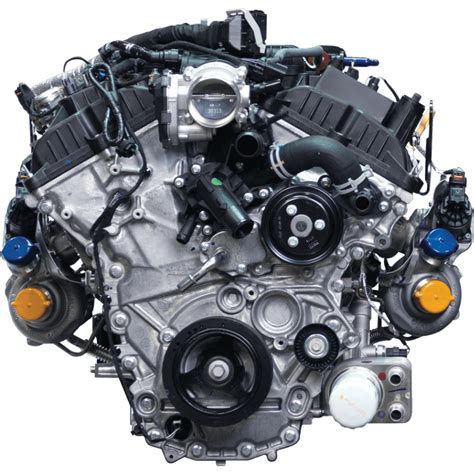
Introduction: A Tale of Two EcoBoosts
In the realm of automotive engineering, the quest for efficiency and performance often leads to the development of innovative technologies. Among these, the EcoBoost engine range from Ford Motor Company stands out as a testament to the company's dedication to delivering both power and fuel economy. At the heart of this range are two prominent engines: the 2.7L and 3.5L EcoBoost V6 units. These engines, while sharing similarities in design and engineering principles, offer distinct characteristics and performance attributes that cater to different driving needs and preferences.Delving into the 2.7L EcoBoost: A Symphony of Power and Efficiency
The 2.7L EcoBoost V6 engine, introduced in 2015, represents a skillful blend of power and efficiency. With a displacement of 2.7 liters, it features a twin-turbocharged configuration that delivers an impressive 325 horsepower and 400 lb-ft of torque. This power is harnessed through a 10-speed automatic transmission, ensuring smooth and responsive gear changes. The 2.7L EcoBoost's compact design makes it an ideal choice for a wide range of vehicles, including the Ford F-150, Expedition, and Edge.Unveiling the 3.5L EcoBoost: Unleashing Unbridled Power
The 3.5L EcoBoost V6 engine, introduced in 2010, has cemented its reputation as a powerhouse among EcoBoost offerings. With a larger displacement of 3.5 liters, it boasts a twin-turbocharged design that generates a remarkable 450 horsepower and 510 lb-ft of torque. This prodigious output is channeled through a 10-speed automatic transmission, providing effortless acceleration and exhilarating driving dynamics. The 3.5L EcoBoost finds its home in vehicles demanding exceptional power, such as the Ford F-150 Raptor, Mustang, and Explorer ST.Design and Engineering: Unveiling the Intricacies
Both the 2.7L and 3.5L EcoBoost engines share a common design philosophy that emphasizes efficiency and performance. They feature aluminum block and head construction, reducing weight and improving thermal management. Direct injection technology ensures precise fuel delivery, optimizing power output and fuel economy. Twin-turbochargers, strategically positioned in a compact layout, minimize turbo lag and provide a linear power delivery across the rev range.Fuel Efficiency: Striking a Balance
While both engines prioritize power, they also strive to deliver impressive fuel efficiency. The 2.7L EcoBoost, with its smaller displacement and optimized design, offers slightly better fuel economy compared to its larger sibling. On average, it achieves an EPA-estimated 20 mpg in the city and 27 mpg on the highway in rear-wheel-drive F-150 configurations. The 3.5L EcoBoost, while delivering exhilarating power, maintains respectable fuel efficiency. It achieves an EPA-estimated 17 mpg in the city and 23 mpg on the highway in rear-wheel-drive F-150 configurations.Towing and Payload Capacity: The Essence of Versatility
Both the 2.7L and 3.5L EcoBoost engines offer impressive towing and payload capacities, making them versatile options for work and leisure. The 2.7L EcoBoost, with its robust torque output, delivers a maximum towing capacity of 8,500 pounds and a payload capacity of 2,250 pounds. The 3.5L EcoBoost, with its prodigious power, boasts a towing capacity of up to 14,000 pounds and a payload capacity of 3,250 pounds. This exceptional capability makes it an ideal choice for hauling heavy loads or towing recreational vehicles.Driving Experience: A Symphony of Performance and Refinement
The 2.7L EcoBoost engine offers a balanced driving experience, blending power and efficiency seamlessly. It delivers responsive acceleration, smooth gear changes, and a satisfying exhaust note. The 3.5L EcoBoost, on the other hand, provides an exhilarating driving experience, characterized by blistering acceleration, effortless overtaking, and a distinctive exhaust rumble. Both engines offer composed handling and precise steering, ensuring a confident and engaging driving experience.Reliability and Durability: A Legacy of Excellence
Ford's EcoBoost engines have earned a reputation for reliability and durability, backed by extensive testing and real-world usage. The 2.7L and 3.5L EcoBoost units are no exception, offering peace of mind to owners. Regular maintenance and adherence to manufacturer-recommended service intervals are essential to ensuring optimal performance and longevity.Choosing the Right EcoBoost: A Matter of Preference
Ultimately, the choice between the 2.7L and 3.5L EcoBoost engines depends on individual preferences and driving needs. For those seeking a balance of power and efficiency, the 2.7L EcoBoost is an excellent choice. It delivers ample power for daily driving and occasional towing or hauling tasks, while maintaining impressive fuel economy. For those prioritizing outright power and towing prowess, the 3.5L EcoBoost is the ideal choice. Its prodigious output and exceptional towing capacity make it a formidable companion for demanding tasks and adrenaline-fueled driving experiences.Conclusion: A Testament to Engineering Excellence
The 2.7L and 3.5L EcoBoost V6 engines stand as shining examples of Ford's commitment to innovation and engineering excellence. They offer a compelling blend of power, efficiency, and versatility, catering to a wide range of driving needs and preferences. Whether it's the balanced performance of the 2.7L or the exhilarating power of the 3.5L, EcoBoost technology delivers an exceptional driving experience that continues to impress.